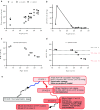Life-long tailoring of management for patients with hypertrophic cardiomyopathy : Awareness and decision-making in changing scenarios
- PMID: 28005231
- PMCID: PMC5313451
- DOI: 10.1007/s12471-016-0943-2
Life-long tailoring of management for patients with hypertrophic cardiomyopathy : Awareness and decision-making in changing scenarios
Abstract
Hypertrophic cardiomyopathy (HCM) is the most common genetic heart disease, characterised by complex pathophysiology and extensive genetic and clinical heterogeneity. In most patients, HCM is caused by mutations in cardiac sarcomere protein genes and inherited as an autosomal dominant trait. The clinical phenotype ranges from severe presentations at a young age to lack of left ventricular hypertrophy in genotype-positive individuals. No preventative treatment is available as the sequence and causality of the pathomechanisms that initiate and exacerbate HCM are unknown. Sudden cardiac death and end-stage heart failure are devastating expressions of this disease. Contemporary management including surgical myectomy and implantable cardiac defibrillators has shown significant impact on long-term prognosis. However, timely recognition of specific scenarios - including transition to the end-stage phase - may be challenging due to limited awareness of the progression patterns of HCM. This in turn may lead to missed therapeutic opportunities. To illustrate these difficulties, we describe two HCM patients who progressed from the typical hyperdynamic stage of asymmetric septal thickening to end-stage heart failure with severely reduced ejection fraction. We highlight the different stages of this complex inherited cardiomyopathy based on the clinical staging proposed by Olivotto and colleagues. In this way, we aim to provide a practical guide for clinicians and hope to increase awareness for this common form of cardiac disease.
Keywords: Diagnosis; Hypertrophic cardiomyopathy; Imaging.
Conflict of interest statement
M. Michels, I. Olivotto, F.W. Asselbergs and J. van der Velden declare that they have no competing interests.
Figures




References
LinkOut - more resources
Full Text Sources
Other Literature Sources

